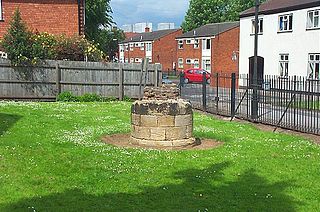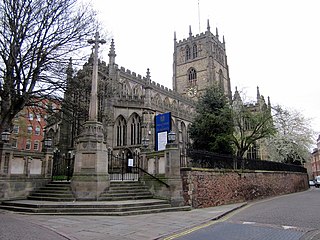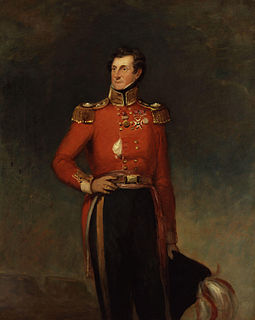The topic of this article may not meet Wikipedia's general notability guideline .(October 2014) |


William Stretton (April 1755 - 12 March 1828) was a builder and architect based in Nottingham. [2]
The topic of this article may not meet Wikipedia's general notability guideline .(October 2014) |


William Stretton (April 1755 - 12 March 1828) was a builder and architect based in Nottingham. [2]
He was the eldest child of Samuel Stretton and was baptised at Lenton on 20 April 1755.
He married Suzanna Lynam, daughter of William Lynam, of Eakring, on 22 June 1778 in Eakring. The marriage produced six children, all of whom were given Christian names starting with “S”.[ citation needed ]
He died in his house at Lenton Priory on 12 March 1828. His death was announced in the Nottingham Journal
“On Wednesday, the 12th inst, in the 73 rd year of his age, after a long and painful affliction, sustained with true Christian fortitude and resignation, William Stretton, Esq., of Lenton Priory. Words would but faintly convey the deep grief which his irreparable loss has occasioned to those who knew his worth. In him antiquarians have lost a fund of general and useful knowledge, and the poor a warm and benevolent friend.
He started as an architect and builder in Nottingham in partnership with his father, and took over the business when his father retired.[ citation needed ] In 1788 he built what is now 43, 45 and 47 in Castle Gate. [3] In the 1790s he made some changes to Newdigate House. [4] In 1799 he is listed as a builder on the Long Row, [5]
He rebuilt the Nottingham Exchange and restored St Mary's Church, Nottingham and St Peter's Church, Nottingham. He built St. James' Church, Standard Hill in 1808 and three houses between 1810 and 1814 on Standard Hill when this area was first developed.
He acquired a portion of land which had previously been the site of Lenton Priory and built a house there which he called Lenton Priory. This was occupied by the Sisters of Nazareth from 1880 [6] who extended it. It has now been restored as part of a housing development, following the sale of the site by the Sisters of Nazareth.
He made a series of excavations on the site of Lenton Priory and discovered a magnificent Norman font which is now housed in Holy Trinity Church, Lenton.
The registers of St. Mary's Church, Nottingham, show that he was Churchwarden from Easter 1802 to Easter 1806. During his residence at Lenton Mr. Stretton took an active interest in all public matters, and filled the several parish offices in an efficient manner. He held the two offices of Overseer of the Poor and Surveyor of Highways in 1806 and was Churchwarden in 1810 and 1811. In 1815 he was appointed one of the Overseers of the Poor for Standard Hill.[ citation needed ]

Lenton is an area of the City of Nottingham, in the county of Nottinghamshire, England. Most of Lenton is situated in the electoral ward of 'Dunkirk and Lenton', with a small part in 'Wollaton East and Lenton Park'.

Asher Benjamin was an American architect and author whose work transitioned between Federal architecture and the later Greek Revival architecture. His seven handbooks on design deeply influenced the look of cities and towns throughout New England until the Civil War. Builders also copied his plans in the Midwest and in the South.

Cluny Abbey is a former Benedictine monastery in Cluny, Saône-et-Loire, France. It was dedicated to Saint Peter.

Burton Joyce is a large village and civil parish in the Gedling district of Nottinghamshire, England, 7 miles (11 km) east of Nottingham, between Stoke Bardolph to the south and Bulcote to the north-east. The A612 links it to Carlton and Netherfield to the south-west and Lowdham to the north-east. Initially the site of an Iron age fort, it was occupied by Norman nobility, who founded St Helen's Church. From being a farming community, Burton Joyce grew in the early Industrial Revolution, earning repute up to the 1920s for its textile products. Many of today's 3,443 inhabitants commute to work or school in Nottingham. It forms with Stoke Bardoph and Bulcote the Trent Valley ward of Gedling, with two councillors.

The Priory Church of St James, Bristol, is a Grade I listed building in Horsefair, Whitson Street.

Lenton Priory was a Cluniac monastic house in Nottinghamshire, founded by William Peverel circa 1102-8. The priory was granted a large endowment of property in Nottinghamshire and Derbyshire by its founder, which became the cause of violent disagreement following its seizure by the crown and its reassignment to Lichfield Cathedral. The priory was home mostly to French monks until the late 14th century when the priory was freed from the control of its foreign mother-house. From the 13th-century the priory struggled financially and was noted for "its poverty and indebtedness". The priory was dissolved as part of King Henry VIII's Dissolution of the Monasteries.

Nathan Haines was an English priest. He was born c.1735/6 and died 27 April 1806.

SS Philip and Jacob Church, previously referred to as Pip 'n' Jay, is a parish church in central Bristol, England. The church that meets there is now called Central. Its full name since 1934 is St Philip and St Jacob with Emmanuel the Unity, although reference to the original church of St Philip exists in records dating from 1174. Historically the 'Mother church of East Bristol', it serves the area known as The Dings.

Thomas Chambers Hine was an architect based in Nottingham.

Holy Trinity Church, Lenton is a parish church in the Church of England Diocese of Southwell.
Henry Isaac Stevens FRIBA was an architect based in Derby. He was born in London, in 1806, and died in 1873. In the late 1850s he changed his name to Isaac Henry Stevens.

The church of St John the Baptist in Tideswell is a Church of England parish church.

The Church of St Mary the Virgin is the oldest religious foundation in the City of Nottingham, England, the largest church after the Roman Catholic Cathedral in Nottingham and the largest mediaeval building in the city.

Colonel Sempronius Stretton (1781–1842) was a British Army officer who served in numerous campaigns including the Battle of Waterloo. He is also known for his sketches that recorded early Canadian life.

Lieutenant-Colonel Severus William Lynam Stretton was a British Army officer who served in the Napoleonic Wars.
Samuel Stretton was a builder and architect in Nottingham who is noted for building the first powered cotton mill.
Stretton is a surname. Notable people with the surname include:

G. & F. Cope Ltd was a clockmaking company based in Nottingham, England from 1845 to 1984.

Robert Evans FRIBA, JP was an English architect based in Nottingham.

William Jolley was an English architect based in Nottingham.